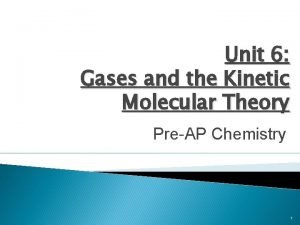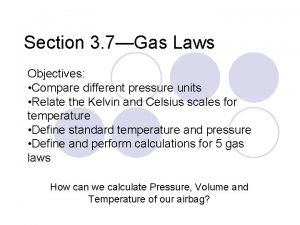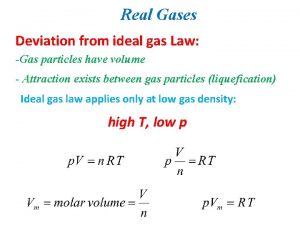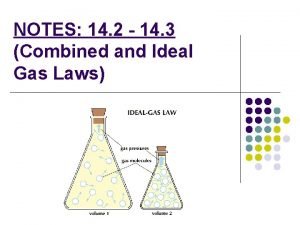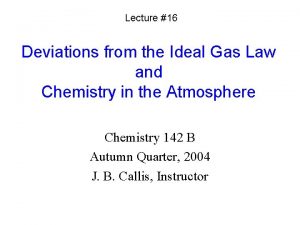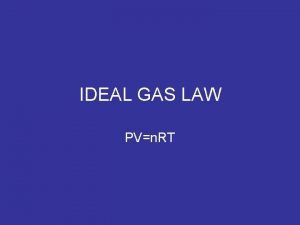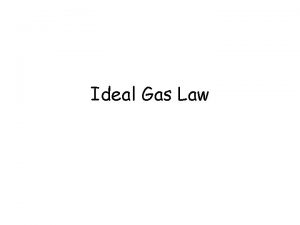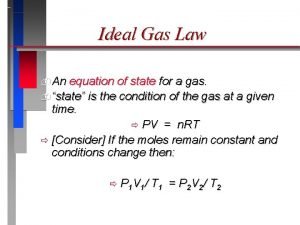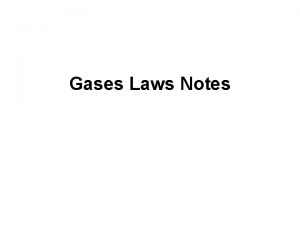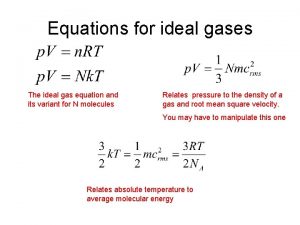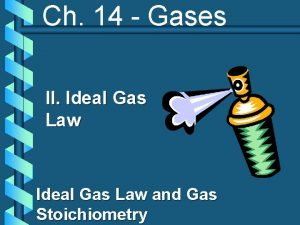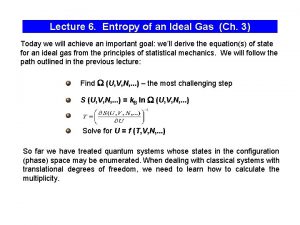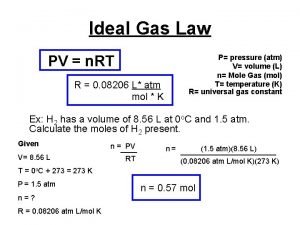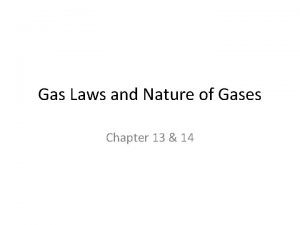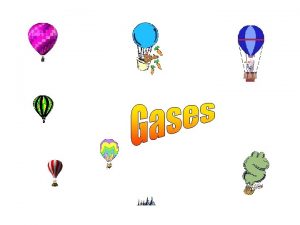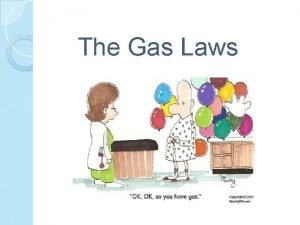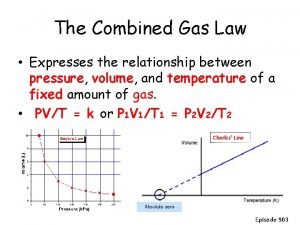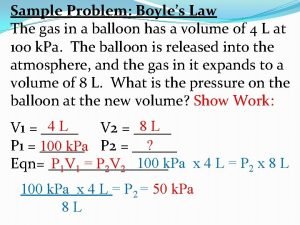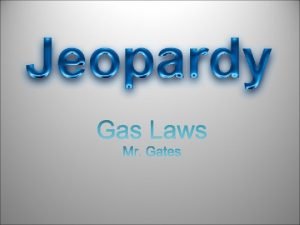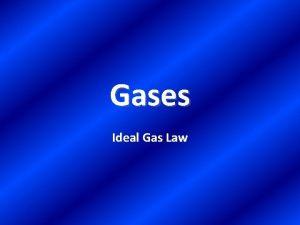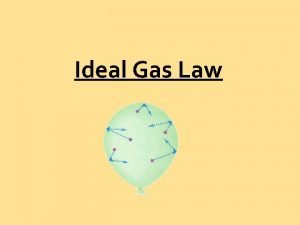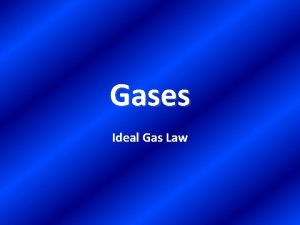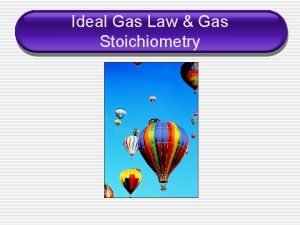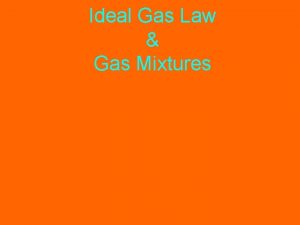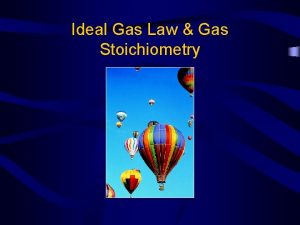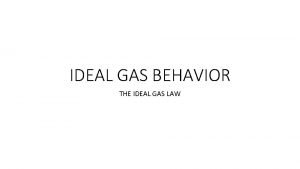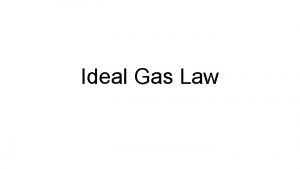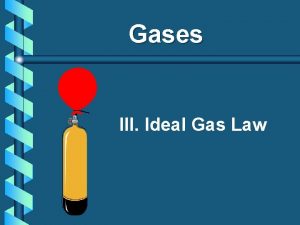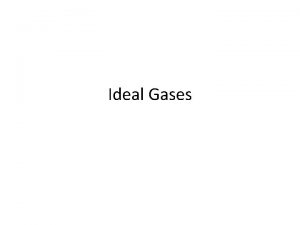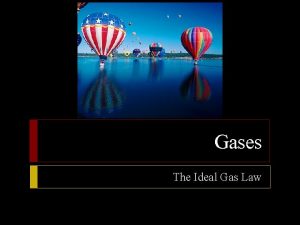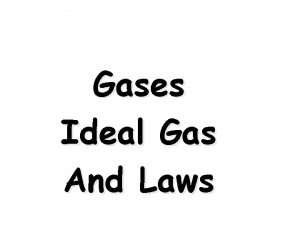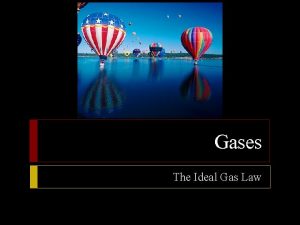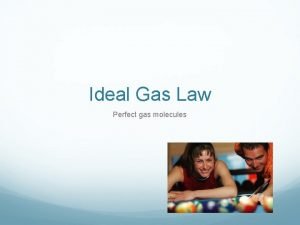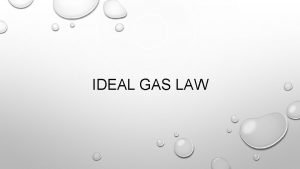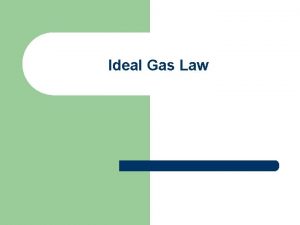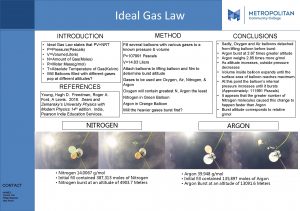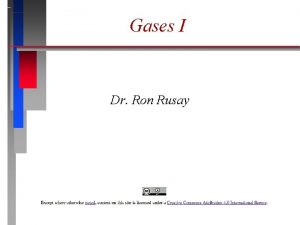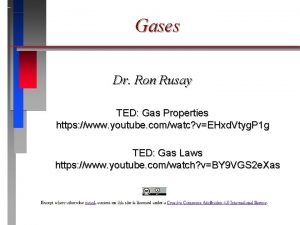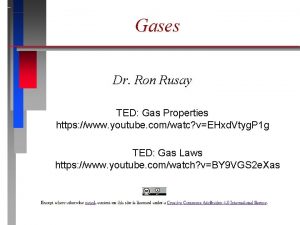Gases II Dr Ron Rusay Ideal Gas Law





























- Slides: 29

Gases II Dr. Ron Rusay

Ideal Gas Law An equation of state for a gas. “state” is the condition of the gas at a given time. ð PV = n. RT ð [Consider] If the moles remain constant and conditions change then: ð P 1 V 1/ T 1 = P 2 V 2/ T 2

QUESTION If a person exhaled 125 m. L of CO 2 gas at 37. 0°C and 0. 950 atm of pressure, what would this volume be at a colder temperature of 10. 0°C and 0. 900 atm of pressure? A) B) C) D) 3. 12 m. L 0. 130 L 0. 120 L 22. 4 L

Ideal Gas Law ð P V = n RT ð R = proportionality constant = 0. 08206 L atm mol P = pressure in atm V = volume in liters n = moles T = temperature in Kelvins ð Holds closely at P < 1 atm ð ð

Standard Temperature and Pressure ð“STP” ð For ð ð ð 1 mole of a gas at STP: P = 1 atmosphere T = C The molar volume of an ideal gas is 22. 42 liters at STP

QUESTION If a 10. 0 L sample of a gas at 25°C suddenly had its volume doubled, without changing its temperature what would happen to its pressure? What could be done to keep the pressure constant without changing the temperature? A) The pressure would double; nothing else could be done to prevent this. B) The pressure would double; the moles of gas could be doubled. C) The pressure would decrease by a factor of two; the moles of gas could be halved. D) The pressure would decrease by a factor of two; the moles could be doubled.


QUESTION A typical total capacity for human lungs is approximately 5, 800 m. L. At a temperature of 37°C (average body temperature) and pressure of 0. 98 atm, how many moles of air do we carry inside our lungs when inflated? (R = 0. 08206 L atm/ K mol) A) B) C) D) E) 1. 9 mol 0. 22 mol 230 mol 2. 20 mol: Moles can harm a person’s lungs.

Do you have enough oxygen to climb Mt. Everest? http: //chemconnections. org/chemwiki/everest. htm

QUESTION The primary source of exhaled CO 2 is from the combustion of glucose, C 6 H 12 O 6 (molar mass = 180. g/mol. ). The balanced equation is shown here: C 6 H 12 O 6 (aq) + 6 O 2 (g) 6 CO 2 (g) + 6 H 2 O (l) If you oxidized 5. 42 grams of C 6 H 12 O 6 while tying your boots to climb Mt. Everest, how many liters of O 2 @ STP conditions did you use? A) B) C) D) 0. 737 L 0. 672 L 4. 05 L 22. 4 L

Dalton’s Law of Partial Pressures ð For a mixture of gases, the total pressure is the sum of the pressures of each gas in the mixture. PTotal = P 1 + P 2 + P 3 +. . . PTotal n Total n. Total = n 1 + n 2 + n 3 +. . .

Dalton’s Law of Partial Pressures ð For a mixture of gases, the partial gas pressure and total pressure equal the mole fraction of each gas in the mixture. P 1 / PTotal = n 1 / n. Total

QUESTION If the mole fraction of O 2 in our atmosphere at standard conditions is approximately 0. 209, what is the partial pressure of the oxygen in every breath you take? A) B) C) D) 1. 00 atm 4. 78 atm 159 torr 3640 mm. Hg

Air Composition

An average pair of human lungs actually contains only about 3. 5 L of air after inhalation and about 3. 0 L after exhalation. Assuming that air in your lungs is at 37°C and 1. 0 atm a) How many moles of O 2 are actually in a typical breath? . b) What is the mass of O 2 in a typical breath? . c) How much of the O 2 is essential biochemically?

QUESTION An average pair of human lungs actually contains only about 3. 5 L of air after inhalation and about 3. 0 L after exhalation. Assuming that air in your lungs is at 37°C and 1. 0 atm: How many moles of air are actually in a typical breath? A) B) C) D) E) 0. 0020 mol 0. 030 mol 0. 025 mol 0. 0042 mol

QUESTION An average pair of human lungs actually contains only about 3. 5 L of air after inhalation and about 3. 0 L after exhalation. Assuming that air in your lungs is at 37°C and 1. 0 atm: How many moles of O 2 are actually in a typical breath? A) B) C) D) E) 0. 0020 mol 0. 030 mol 0. 025 mol 0. 0042 mol

An average pair of human lungs actually contains only about 3. 5 L of air after inhalation and about 3. 0 L after exhalation. Assuming that air in your lungs is at 37°C and 1. 0 atm c) How much of the O 2 is essential biochemically?

Applying the Ideal Gas Law PV = n RT ð n = g of gas/ MM gas [MM gas =g/mol] ð PV = (g of gas/ MM gas )RT ð MM gas = g of gas(RT)/PV ð MM gas = g of gas/V (RT/P) ð MM gas = density of gas (RT/P) ð

QUESTION Under STP conditions what is the density of O 2 gas? A) B) C) D) Not enough information is given to solve this. 1. 31 g/L 1. 43 g/L 0. 999 g/L

QUESTION Which sequence represents the gases in order of increasing density at STP? A) Fluorine < Carbon monoxide < Chlorine < Argon B) Carbon monoxide < Fluorine < Argon < Chlorine C) Argon < Carbon monoxide < Chlorine < Fluorine D) Fluorine < Chlorine < Carbon monoxide < Argon

QUESTION The density of an unknown atmospheric gas pollutant was experimentally determined to be 1. 964 g/ L @ 0 o. C and 760 torr. • What is the molar mass of the gas? • What might the gas be? A) CO B) SO 2 C) H 2 O D) CO 2

QUESTION Freon-12 had been widely used as a refrigerant in air conditioning systems. However, it has been shown to be a greenhouse gas and destroy the ozone layer. What is the molar mass of Freon-12 if 9. 27 grams was collected by water displacement, in a 2. 00 liter volume at 30. 0°C and 764 mm. Hg. Water’s vapor pressure at this temperature is approximately 31. 8 mm. Hg. A) B) C) D) 120. g/mol 12. 0 g/mol 115 g/mol 92. 7 g/mol

QUESTION An organic compound, which had the aroma of fresh raspberries, was synthesized by a DVC Chem 298 student. Elemental analysis produced the following results: C% = 73. 15 ; H% = 7. 37 ; O% = 19. 49. The empirical formula of the compound is: A) B) C) D) E) C 2 H 3 O C 3 H 5 O C 3 H 3 O C 5 H 6 O C 6 H 7 O

QUESTION 0. 0820 grams of the volatile, gaseous phase, of the compound in the previous question, which smells like fresh raspberries, was trapped in a syringe. It had a volume of 12. 2 m. L at 1. 00 atmosphere of pressure and 25. 0°C. What is the molar mass of this pleasant smelling compound ? A) B) C) D) 13. 8 g/mol 164 g/mol 40. 9 g/mol 224 g/mol

QUESTION Based on your answers in the previous two questions for the compound that smells like fresh raspberries, the following structure matches its molecular formula. A) TRUE B) FALSE

QUESTION An organic compound, which had the aroma of fresh raspberries, was synthesized by a DVC Chem 298 student. Elemental analysis produced the following results: C% = 73. 15 ; H% = 7. 37 ; O% = 19. 49. The empirical formula of the compound is: A) B) C) D) E) C 2 H 3 O C 3 H 5 O C 3 H 3 O C 5 H 6 O C 6 H 7 O

QUESTION 0. 0820 grams of the volatile, gaseous phase, of the compound in the previous question, which smells like fresh raspberries, was trapped in a syringe. It had a volume of 12. 2 m. L at 1. 00 atmosphere of pressure and 25. 0°C. What is the molar mass of this pleasant smelling compound ? A) B) C) D) 13. 8 g/mol 164 g/mol 40. 9 g/mol 224 g/mol

QUESTION Based on your answers in the previous two questions for the compound that smells like fresh raspberries, the following structure matches its molecular formula. A) TRUE B) FALSE
 Rusay
Rusay Ideal gas vs perfect gas
Ideal gas vs perfect gas An ideal gas is an imaginary gas
An ideal gas is an imaginary gas Differences between ideal gas and real gas
Differences between ideal gas and real gas Computational fluid dynamics
Computational fluid dynamics Difference between ideal gas and real gas
Difference between ideal gas and real gas Ideal gas law with mass
Ideal gas law with mass How to find initial pressure in boyle's law
How to find initial pressure in boyle's law Charles law
Charles law Which equation agrees with the ideal gas law?
Which equation agrees with the ideal gas law? Deviations from ideal gas law
Deviations from ideal gas law Ideal gas law mmhg
Ideal gas law mmhg Deviations from the ideal gas law
Deviations from the ideal gas law Graph of ideal gas equation
Graph of ideal gas equation Avogadro's law
Avogadro's law State ideal gas law
State ideal gas law Temperature and pressure relationship
Temperature and pressure relationship Gas formula
Gas formula Ideal gas law formula
Ideal gas law formula How to find density in ideal gas law
How to find density in ideal gas law Ideal gas law to find density
Ideal gas law to find density Pzmore
Pzmore Pv nrt
Pv nrt C to k
C to k Derive the ideal gas equation
Derive the ideal gas equation Characteristics of ideal gas
Characteristics of ideal gas Ideal gas law examples
Ideal gas law examples N in ideal gas law
N in ideal gas law Sample problem about boyle's law
Sample problem about boyle's law Ideal gas law powerpoint
Ideal gas law powerpoint






